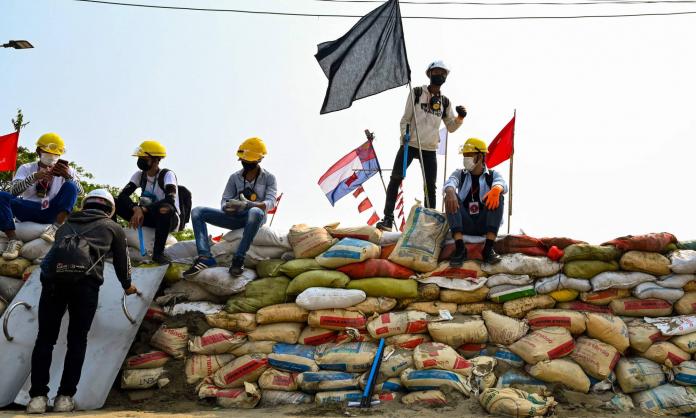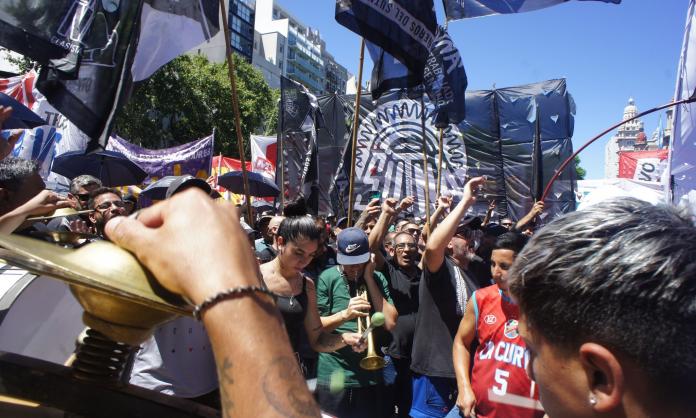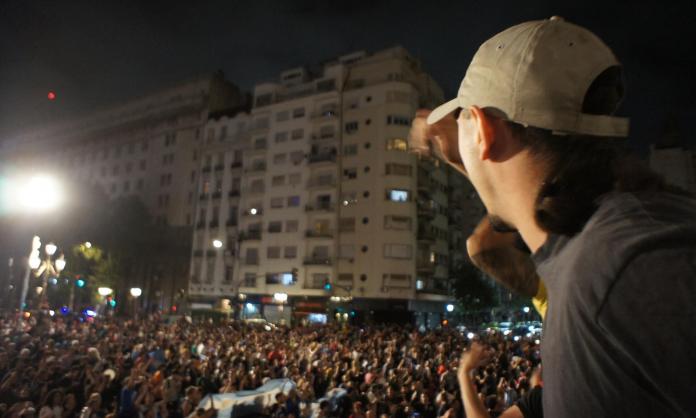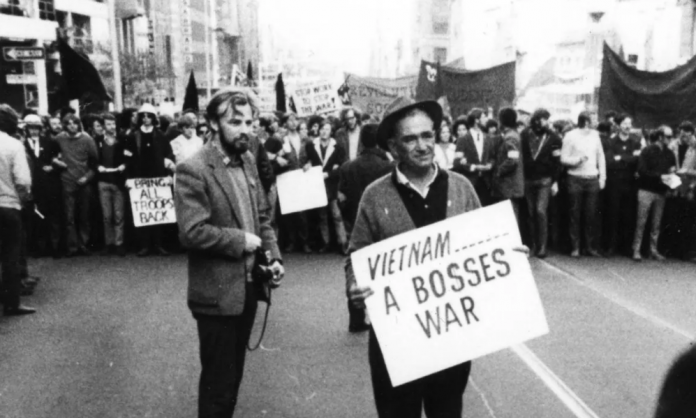Video footage shows students in gasmasks and hard hats assembled in a row, armed with homemade shields, in Tamwe township, east central Yangon. They crouch behind a barricade built from bamboo sticks, bags of rice, garbage bins and bricks. Several hundred metres away, a line of riot police fires rubber bullets and tear gas. The bullets lodge in the barricade and ricochet off the students’ shields into the adjacent shopfronts.
Behind the students is a group charged with countering tear-gas volleys. Bags of water and pieces of cloth are used to smother the discharging cannisters. Some are dousing them with a fire extinguisher. Some are lobbing the cannisters back at the police. Another group bombards the security forces with homemade projectiles. A group of medics is on stand-by to treat anyone suffering from the fumes.
“We are the front-liners”, Kelvin* says over the phone from Myanmar. He worked as a librarian before joining a group in the township, one of hundreds of similar front-line groups operating throughout the country’s two largest cities, Yangon and Mandalay. Kelvin says the role of the front-liners is to protect demonstrators from the police and the military by spreading their forces thin. “We know that we can be arrested or killed by live rounds when the police and soldiers shoot at us—but we have to defend our comrades.”
A couple of blocks away, behind two makeshift barriers erected to separate security forces from protesters, several dozen students and workers have gathered for a demonstration. Days earlier, in the same location, a crackdown resulted in at least 389 university students arrested and detained by the Tatmadaw (the military). This time, however, there are no police in sight—they are busy dealing with the front-liners. Later, the students will be charged for inciting mutiny within the armed forces. But after a series of demonstrations across Yangon, many of the students were freed on 24 March.
“We are very fortunate to be alive”, Aung Maung* explains via Signal. He is one of the detained students from the University of Yangon, speaking the day after his release from Insein Prison. “Dozens of us were crammed into the same cell with no medical treatment for our injuries”, he says. “There was little water for bathing or drinking. A number of student leaders were interrogated. A number of them were tortured. It is good to be free but many of our comrades remain in prison and we fear for their lives. We can’t rely on legal procedures to free them because the Tatmadaw are a law unto themselves. We will need to keep up the pressure. I will fight for the abolition of the Tatmadaw to the last day and to my last breath. Only once the Tatmadaw is destroyed will we have justice.”
Throughout Myanmar’s history, students have been at the forefront of resistance to the Tatmadaw. During the 1988 uprising, they played a leading role in demonstrations that challenged the previous military junta. But after the movement was defeated, many universities were closed, and students fled the country. During the period of civilian rule, many universities, such as the University of Yangon, reopened. And student radicals have been busy organising during that time.
“We had to fight the administration and supporters of the old regime to re-establish our student unions”, Aung Kaung Sett, a representative from the University of Yangon Students’ Union (UYSU), says over the phone from Yangon. “We presented students with the argument that student unions are political bodies that are meant to fight against injustice. In 2019, UYSU was finally re-established on that basis.”
Aung says that student radicals from across Yangon have supported every strike and riot in the city during the period of civilian rule. “The student unions and trade unions have a strong tradition of supporting each other. Through our activism, students have begun to learn the power of solidarity. But students have also learned that workers have a type of power that students do not have—the power to shut down the economy.”
Beginning on 8 March, the latest general strike paralysed Myanmar’s economy: banks, shipyards, transport, railways, major factories, large farms, oil refineries, mines, hospitals, schools, shopping centres and marketplaces have been shut down with the aim of toppling the new military junta. A core section of the strike movement that laid the basis for the latest general strike has been rail workers, who began striking in early February after refusing to transport soldiers who were to be used as strikebreakers.
“We are part of the engine of this revolution”, Ko Ko Zaw,* a train driver, says from Yangon. Along with hundreds of railway workers and their families living near Ma Hlaw Gone station in Yangon’s Mingalay Taung Nyunt township, Ko was forced to flee his home after the area was surrounded by regime forces. (Similar scenes took place in Mandalay the following week.) But Ko says that nothing will break the resolve of striking rail workers: “I would rather die of hunger and homelessness than go back to work under this fascist regime. Fortunately, we have a lot of support from people.”
A vast support network, stretching from trade unions to community groups, is helping to sustain the striking workers. These supporters collect necessities: food, water, beverages, money, medical aid and the equipment needed to build barricades. In many cases, supporters shelter workers and students who are avoiding arrest or, in the case of the railway workers, provide them with a place to stay after being evicted from their homes. “If you are doing CDM [civil disobedience movement] and need support—or know someone who is protesting and at risk of being harmed by the military—people like me are here to fill that gap”, says Z,* a professional staff member at a private bank in Yangon, who became a supporter in the days after the 1 February coup.
“Before the coup, I had no interest in politics”, Z says. “Then the coup happened. I knew I could not accept it, but I did not know what to do. On 6 February, I was at my friend’s place and for the first time in my life I saw people marching. The next day, I went to Hledan Junction [one of the major gathering points in the early weeks of the revolution] to see how things are going. That’s when I started to become a supporter—collecting things that the protesters need. I do not have the same courage as the front-liners or the workers who are on strike. But there is always something you can do to help. Everyone has a role to play in the revolution.”
Across town, the industrial district of Hlaing Tharyar is still reeling after a day of bloodshed on 14 March in which at least 60 workers and students were gunned down by security forces. “The real death [toll] is much higher because many are hiding the bodies from the military to evade persecution”, Ma Su Su Wai,* a garment worker and member of the Federation of General Workers Myanmar, says over the phone. “Our township now resembles a war zone. But even with martial law, workers still fight.”
Like many garment workers, Ma Su Su Wai migrated from a rural area—in her case, the Ayeyarwady Region—after her parents were pushed off the land by large-scale farming and military operations, endowing her with a deep-seated hatred for the Tatmadaw. As a first-generation garment worker, she has overcome many of the traditional norms of rural life that discourage women from participation in public life. “When I first started engaging in worker protests and strikes, my parents were very worried. But my husband is very supportive of my union activism—he always encourages me.”
In recent years, student activists from around Yangon have also encouraged workers who have gone out on strike. And when the resistance to the new military junta began, it was students who contacted the garment workers with a proposal to join forces. “We are used to strikes at the factories, but striking against the military with guns is different. We have not engaged in political strikes before. But the students have plenty of this experience. And around these parts, many workers know that the students always support the workers when they strike”, Su says.
Aung Kaung Sett says that student opposition to state-sanctioned crimes against ethnic minorities was also an important aspect of student activism prior to the coup. After the re-establishment of the UYSU in 2019, student radicals like Aung used the resources of the union to campaign for the Rohingya. “Before the revolution, we were very isolated in our opposition to the Rohingya genocide”, he says. “Not only did supporters of the Tatmadaw attack us, but so too the supporters of the NLD [National League for Democracy—Aung San Suu Kyi’s party]. But no matter how isolated you are, it is important to take a stand against injustice.”
Last year, when William Schabas, a lawyer who represented the Tatmadaw and the NLD at the International Court of Justice, visited their campus, UYSU organised a demonstration and distributed leaflets that read: “If the current age accuses everyone who demands justice for the victims of mass murder—including the Rohingya—of being an ‘enemy of the state’, then we have no choice but to declare ourselves precisely that: ‘enemies of the state’”.
Myanmar is a mosaic of ethnic minorities, with 135 recognised ethnicities that have been grouped into eight ethnic regions in the borderlands of the country. Since independence from British rule in 1947, the majority Bamar, who form the bulk of Myanmar’s ruling class, including the Tatmadaw, have used these ethnic divisions to pit the population against each other. Importantly, many ethnic groups have their own armed militias, known as Ethnic Armed Organisations, including the Kayin, Kayah, Mon, Shan, the Arkan Army, the Ta’ang National Liberation Army, the Kachin Independence Army and the Karen National Union, to list some of the most powerful.
The military’s light infantry divisions (LIDs), which have been crushing anti-regime protests across Myanmar, are repeating the abuses carried out in ethnic-minority areas for decades. Formed in the 1960s, the LIDs have carried out atrocities against not only the Rohingya, but the Rakhine, Ta’ang, Shan and Kachin, to name only a few. Bamar chauvinism is used to cohere ideologically the Tatmadaw’s ranks and tie the infantry, drawn from the poorest areas of the country, to the commanding officers and generals, who form the core of Myanmar’s middle and capitalist classes. David Scott Mathieson, writing at the news site Irrawaddy, says:
“Many of the LIDs instil a sadistic esprit de corps and brag about their abusive excesses. When they rotate through different parts of Myanmar they often intimidate civilians with tales of their cruelty elsewhere. It is a fallacy to claim LIDs only perform frontline operations when often static garrison troops can be just as abusive ... Myanmar has not fostered a culture of ‘death squads’ per se but a broader pattern of Tatmadaw troops being abusive almost everywhere they go. The entire organisation acts as a death squad.”
The question of how to overpower the police and split the Tatmadaw is now a central question for the movement. Many students, and in some cases migrant workers from rural areas, are fleeing the cities to the countryside to join the Ethnic Armed Organisations. A parallel government, the Committee Representing Pyidaungsu Hluttaw, has formed in Karen-controlled territory and is building alliances with other groups. Many police officers who have defected are also seeking refuge in these areas. A number of Ethnic Armed Organisations have also begun to protect demonstrations and striking workers.
Many of the front-liners agree that any attempt at an insurrection will need a mass character. “We need one hundred Hong Kongs”, Kelvin argues, referring to the character of the street-fighting in the 2019 uprising, from which front-liners like him have drawn inspiration and many lessons. “The main reason is that, unlike Hong Kong, the military has used sound bombs and mixed real bullets with rubber bullets. That’s why even when we use steel shields, we are being shot to death. We can ambush the army and the police, but they are violently suppressing the local people when we retreat. There are 7 million people in Yangon; if they all take to the streets, it will be impossible for the police and military to crack down.”
The threat of increasing militarisation is an ever present danger. But Aung Kaung Sett says that, as long as the working class in the cities remains the engine of the revolution, the Tatmadaw’s economic and political power will continue to be tested. “We have learned from past generations that the working class is the key to victory in this struggle. And from them we have learned that you must never give up and never give in. We are sending a message to all future generations: another world is possible, and Myanmar’s working class is showing us how. That is why we all say: ‘The revolution must win!’”
* Names have been changed to protect identities.











